Indian Ocean: Mayotte to South Africa
Stopping over in Mayotte on their way from the Chagos Archipelago to South Africa, cruisers Maryanne and Kyle Webb found an island of contrasts.
Published 2 years ago

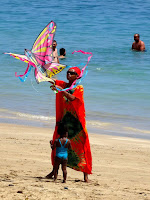
- Kite-flying on the beach in Mayotte.
MAYOTTE
Mayotte is a French ‘department’ which puts it closer to being ‘properly French’ than even Tahiti. We were expecting good things and I dreamed of shopping again in a Carrefour. We certainly squeezed in some great stuff, but the general reality was all a little grubby unfortunately. Lots of trash in the streets, very limited fresh provisioning and lots of economic immigrants (many homeless), some resorting to the crime of easy muggings which forced us to cancel any plans we had to walk the great volcanic craters.
Hopefully soon, Mayotte will catch up on those fronts and become the Tahiti of the Mozambique Channel. Getting around was easy (via the ‘taxi’ system), and entry/exit process was relatively slick, and the yacht club was a great help on many fronts. Getting out to the moorings around the Atoll was very much worth the effort and we wish we’d spent more time doing that than searching for impossible (basic, fresh) provisions.
So here are some notes from our time on Mayotte.
Anchoring:

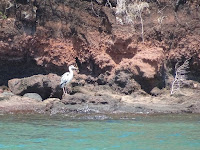
- Birdlife on Mayotte.
Anchoring is only permitted at the one place, Dzaoudzi,where most will arrive to clear in. However there are Park moorings all around the main island (and on some of the smaller islands). Just be careful to match the mooring to your boat weight. See this free park Mooring map.
Clearance:
Clearing in helps if you have a printer and can receive attachments via your device email account, as the port clearance can then be done via email. Customs and Immigration require a trip to the airport (walk or taxi) and then sending (or emailing) a copy to the port captain.
Dinghy Dock:
The dinghy dock is located to the south of the ferry landing and navy/police dock. It’s a floating dock but often crowded and can be subject to swell.
Money:
There is an ATM at the Dzaoudzi ferry landing (near the dinghy dock and just inside the entrance cage). There are no entry restrictions, so you can come and go as you please into the ‘cage’ area and get some Euros to start spending.


- Mayotte Ferry
Getting Around:
There is a Ferry between Dzaoudzi and Main island – 75c for a return trip (you only pay one way), the ferries run regularly and seem in good order. Taxis – are ‘collective’ or ‘bush’ – meaning they may pick up other passengers during your ride (more like an on-demand bus, but a car). It’s €2 per person per ride for most trips (fuel cans / groceries may be € extra per can/bag). Taxis can be found at most public places or just hailed as you see them.
Communications:
Internet is free at the yacht club (buy a drink). Also laundry machines at €1.50 per load!
There are three major SIM providers: Orange; Only; and SFR (and other smaller providers no doubt). We opted to use SFR, but others told us that Orange was OK as well. With SFR we paid €2 for a SIM that came with 3GB free and then paid €5 for 5GB (lasts for 5 days). We went with a data-only plan. If you top up at the machines in official SFR stores, then extra data is automatically added (at least that was offered during our visit). Verify in store that internet and hot spot is working (and ask how to top up if required).

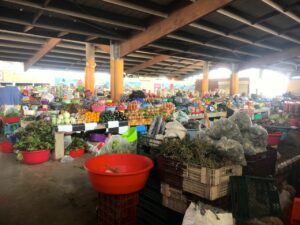
- Covered Market in Mayotte
Groceries:
There are covered markets on the Main and Petit Islands. In the afternoons there are a few women selling veggies at the ferry landing area. We found supermarkets were poorly stocked with fruit and veg, often they would have nothing, or maybe just pears and lots of empty areas. Also we were surprised (even at the markets) at the lack of fruit/veg options. Carrots and potatoes were hard to come by. Grapes and avocados seemed an impossible dream.
- Dzaoudzi – a big covered market at Mamoudzou by the ferry landing.
- Supermarkets on Petit – Carrefour, Sodifram (Kawani).
- The Mall on Grand terre also has a hardware store (Mr Bricologe) and grocer.


- Baobab Tree on Mayotte
Marine Supplies:
There is a chandlery on Grand Terre – SV Nautique – not a great amount of stock, but very helpful.
Snorkelling:
The snorkelling here was better than expected. You can expect to see turtles, fish, dolphins, and if you are lucky manta rays and even dugong.
SOUTH AFRICA
Load shedding in South Africa:
I have also included notes on Load Shedding in South Africa because when you get here you are going to hear about this (Planned Power Outages) pretty quickly.
As I understand it, Load Shedding is a planned power outage due to power grid and demand issues – areas of each grid/network deliberately have the power stitched off (often for two hours a day – sometimes more). This may be locally (daily or weekly) or even nationwide (more rarely).
I thought we would be fine, as the the boat is off the grid anyway – but it is really useful to know the load shedding times of the areas you visit.
Local cell phone towers are without power during load shedding – they have backup batteries to cover this, but these don’t always last the full downtime (and are sometimes stolen anyway) – so if your signal fails, this is often the reason (avoid planning critical calls and zoom-meetings where you will need phone/data connection during such times).

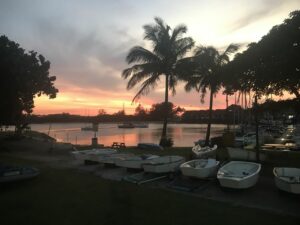
- Richards Bay, South Africa
Even if power is up where you are – we found ATMs often didn’t work since the hub server was under load shedding. We found some services at the mall were impossible (e.g. getting a SIM card – since servers were down at one end or the other). A doctor’s visit was interrupted while we waited for generators to kick in and attempts to make online payments for customs duty repeatedly failed, etc….
There are apps that tell you when to expect load shedding by area (ask the locals which zone you are in – each town seems to have multiple areas so the mall is often different from the anchorage/dock areas). Such apps include ‘LoadShedding’ or ‘EskomSePush’. Also community Facebook pages tend to post details.
While many businesses have their own generators, some restaurants may pause service (not always) and some shops just close their doors. Traffic light junctions revert to four way stops.
Load Shedding really is something you need to know about and most activities can be made easier if you plan/call ahead so as to avoid, or allow for, load shedding times.
The referred app (for everyone we ask in South Africa) is EskomSePush and Traffic lights are called Robots!
Maryanne and Kyle Webb
SV Begonia
……………………………………………………………………………………………………………………………………
About the Authors:
With a desire to actively “steer” their lives rather than safely continue on the conveyor belt of life, Maryanne and Kyle Webb merged their dreams and set out on a life of cruising the world more than 20 years ago. For many years their cruising was interrupted with periods based in one place to “stuff-the-kitty”, but since 2016 they have been full-time cruisers.
Portrait of a Cruiser – Maryanne and Kyle Webb


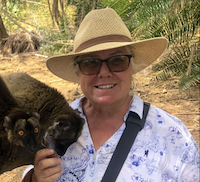

……………………………………………………………………………………………………………………………………
Read more on Mayotte:
http://sv-footprint.blogspot.com/2022/11/mayotte.html
Snorkel tips:
https://www.snorkeling-report.com/destination/snorkeling-mayotte/
https://generationvoyage.fr/spots-plongee-mayotte/
Read more on South Africa:
http://sv-footprint.blogspot.com/2022/11/central-northeastern-south-africa.html
More reports by Maryanne and Kyle on Noonsite.
………………………………………………………………………………………………………………………………………
The opinions expressed in this article are the author’s own and do not reflect the view of Noonsite.com or World Cruising Club.
………………………………………………………………………………………………………………………………………
Find out all news, reports, links and comments posted on Noonsite, plus cruising information from around the world, by subscribing to our FREE monthly newsletter. Go to https://noonsite.wccstaging.com/newsletter/.
Related to following destinations: Dzaoudzi, Mamoudzou, Mayotte, South Africa
Related to the following Cruising Resources: Circumnavigation, Circumnavigation, Indian Ocean, Routing


